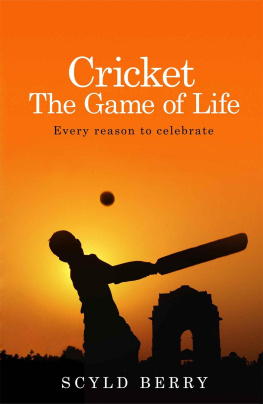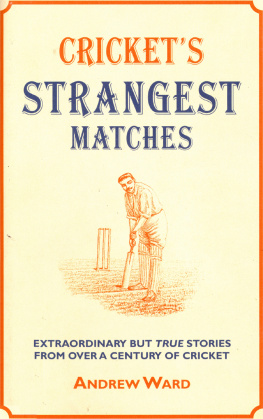THE JOY OF CRICKET
Copyright Graham Tarrant, 2014
Illustrations Shutterstock
All rights reserved.
No part of this book may be reproduced by any means, nor transmitted, nortranslated into a machine language, without the written permission of thepublishers.
Graham Tarrant has asserted his right to be identified as the author of thiswork in accordance with sections 77 and 78 of the Copyright, Designs andPatents Act 1988.
Condition of Sale
This book is sold subject to the condition that it shall not, by way of tradeor otherwise, be lent, re-sold, hired out or otherwise circulated in any formof binding or cover other than that in which it is published and without asimilar condition including this condition being imposed on the subsequentpurchaser.
Summersdale Publishers Ltd
46 West Street
Chichester
West Sussex
PO19 1RP
UK
www.summersdale.com
eISBN: 978-1-78372-230-3
Substantial discounts on bulk quantities of Summersdale books are available to corporations, professional associations and other organisations. For details contact Nicky Douglas by telephone: +44 (0) 1243 756902, fax: +44 (0) 1243 786300 or email: .
For Abigail, Francesca and Rose,
my three cricketing maidens
CONTENTS
INTRODUCTION
The playwright Harold Pinter once referred to cricket as the greatest thing that God created on earth (certainly greater than sex, he went on, although sex isnt too bad either.).
Indeed for many cricket has a significance that goesbeyond the game itself. I can remember the keynotespeaker at our school speech day alerting our youngminds to the fact that life would bowl us theoccasional googly, which we should alwaysendeavour to play with a straight bat. A fewyears later I heard a clergyman in the Cotswolds inform his congregationthat if they wanted to stay in Godsgood books they shouldntthrow their wicket awaywith a careless shot. Itwas their moralshe had inmind.
In the days of the British Empire the spirit of cricket was the essenceof good sportsmanship, a code of conduct akin to medieval chivalry.Almost any dishonourable behaviour was contemptuously dismissedwith the damning phrase: Its not cricket. The notion persisted thatthe game was a universal force for good. As the Cold War extendedits icy grip across the face of the world in the late 1940s, the CatholicArchbishop of Liverpool was heard to observe, If Stalin had learnedto play cricket the world might now be a better place to live in.
The truth is that cricket means different things to different people while remaining totally incomprehensible to countless others,including the French who, despite this, sometimes claim to haveinvented it. No other sport is as multi-faceted or as rich in history,character and drama. No other sport is as well documented or canmatch crickets vast literary output. It is a game of strategic complexity,subtle skills and blatant aggression; though not necessarily at thesame time.
The joy of cricket is that there is so much to enjoy as a player, as aspectator, as a statistician, as a student of the sports history, or evenas an artist like Jocelyn Galsworthy or wicketkeeper-turned-painterJack Russell. What other sport can be played over five fluctuatingdays and build to a nail-biting climax such as weve seen in recenttimes? And the shorter formats of the game have brought their ownbrand of excitement, especially Twenty20. Some purists resent theintroduction of the latter, seeing it as a brash intruder, a corruptinginfluence. But Twenty20 has brought some much needed moneyinto cricket, has attracted a new and generally younger audience andgiven the summer game yet another dimension (not least byextending the playing hours).
Of course, not all Test matches and limited-overs games culminatein an exciting climax. Except for the most partisan supporters,outcomes that are too one-sided can dull the appetite, but even thenthere are likely to be individual performances to admire, promisingnewcomers to note. And if rain stops play, the wise cricket fan willmake sure they have the latest Wisden or some other cricketing tometo hand to help soak up the loss of action.
Playing the game is the greatest joy of all. For those, like me,who have never progressed beyond modest club level there are therecurring pleasures of each new season: the fresh ambition to recorda personal best; the team camaraderie; the unmistakable sense ofcarrying on a long tradition. Less sensitive than the professionals to the weather and state of the pitch, the club cricketer is only toohappy to get out there and do their bit. Ive been fortunate enough towatch Test cricket around the world, but for my money nothing beatsa convivial club game on the village green with afternoon tea linedup in the pavilion and the local pub reassuringly within sight. Cricketat the grass roots.
To do justice to the evolution of cricket, to its milestone eventsand heroic feats, its memorable characters and off-field dramas,to records set and broken, would take a book many times largerthan this. But hopefully this latest addition to the games ever-expanding library will give a taste of what makes cricket so endlesslyfascinating. And such a joy.
CHAPTER 1
CRICKETS FORMATIVE YEARS
Cricket is the greatest game that the wit of man has yet devised.
SIR PELHAM WARNER (MIDDLESEX AND ENGLAND)
In the beginning
The origins of cricket are lost inthe mists of time. No one knowsexactly how or where it all began,but by the mid-sixteenth centurythere is clear evidence of the gamebeing played by children in Surreyas recalled by a witness in a courtcase in 1598, looking back to hisown childhood fifty years before. Also in 1598, an Italian-Englishdictionary compiled by John Florio refers to playing cricket-a-wicket.The development of the game over the next hundred years was centredin the south-east of England the counties of Kent, Sussex and Surrey.
Crickets first known fatality is one Jasper Vinall, whose untimelydeath took place at Horsted Green, East Sussex, in 1624. He wasstruck on the head by the batsman, who was trying to hit the ball asecond time to avoid being caught.
The English aristocracy and gentry took up the game, attractedas much by its gambling potential as by the sport itself. In theliberated years that followed the restoration of the monarchy in1660 gambling was rife in all sports, and cricket was no exception.Wealthier patrons sponsored their own teams (often to improve theirchances of winning) and employed the best exponents of the game,who became the first professional cricketers. Bats were shaped likethe modern hockey stick, the curved base better able to deal with theunderarm deliveries that were bowled along the ground. The wicketcomprised two stumps with a single bail. Neither the batsman northe wicketkeeper wore pads or gloves. Scorers kept a tally of the runsby making notches on a stick, every tenth notch cut larger to help withthe adding up, and there were four balls to an over.

















